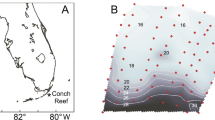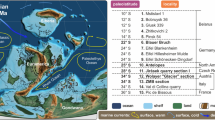Abstract
Darwin1 was first to draw attention to the unique set of climatic data offered by coral reefs that are preserved on tectonically-active coasts. Geologists have since endeavoured to apply a variety of stratigraphic and radiometric dating techniques2–4 during their palaeoclimatic investigations of Quaternary coral reefs but the utilization of stable oxygen isotope ratios, so ubiquitous in deep-sea core studies, has not been fully exploited5,6. I report here the results of an oxygen isotope abundance study of the giant clam Tridacna gigas from a sequence of uplifted coral reefs in New Guinea which provides a detailed record of changes over the past 105 yr in the surface ocean isotope chemistry and temperature. The combined utilization of sea level and 18O/16O data allows a quantitative evaluation of ice volume and temperature factors. The results also contribute to resolving the question as to the exact time-relationship between temperature change at low latitudes and ice accumulation at the latitudes of the glacial ice caps.
This is a preview of subscription content, access via your institution
Access options
Subscribe to this journal
Receive 51 print issues and online access
$199.00 per year
only $3.90 per issue
Buy this article
- Purchase on Springer Link
- Instant access to full article PDF
Prices may be subject to local taxes which are calculated during checkout
Similar content being viewed by others
References
Darwin, C. in The Structure and Distribution of Coral Reefs 1842 (University California Press, Berkeley and Los Angeles, republished 1962).
Mesolella, K. J., Matthews, R. K., Broecker, W. S. & Thurber, D. L. J. Geol. 77, 250–274 (1969).
Bloom, A. L., Broecker, W. S., Chappell, J., Matthews, R. K. & Mesolella, K. J. Quat. Res. 4, 185–205 (1974).
Bloom, A. L. in Earth Rheology, Isostasy and Eustasy (ed. Morner, N. A.) 505–516 (Wiley, New York, 1980).
Fairbanks, R. G. & Matthews, R. K. Quat. Res. 10, 181–196 (1978).
Shackleton, N. J. & Matthews, R. K. Nature 268, 618–619 (1977).
Chappell, J. Bull. geol. Soc. Am. 85, 553–570 (1974).
Veeh, H. H. & Chappell, J. Science 167, 862–865 (1970).
Chappell, J. & Polach, H. Bull. geol. Soc. Am. 87, 235–240 (1976).
Aharon, P., Chappell, J. & Compston, W. Nature 283, 649–651 (1980).
Stuiver, M., Heusser, C. J. & Yang, I. C. Science 200, 16–21 (1978).
Chappell, J. & Veeh, H. H. Bull. geol. Soc. Am. 89, 356–368 (1978).
Konishi, K., Omura, A. & Nakamichi, O. in Proc. Sec. int. Coral Reef Symp. Brisbane 2, 595–613 (1974).
Aharon, P. thesis, Australian National University, Canberra (1980).
Craig, H. Geochim. cosmochim. Acta 12, 133–149 (1957).
Epstein, S., Buchsbaum, R., Lowenstam, H. & Urey, H. C. Bull. geol. Soc. Am. 64, 1315–1326 (1953).
Emiliani, C. J. Geol. 74, 109–126 (1966).
Shackleton, N. J. & Opdyke, N. D. Quat. Res. 3, 39–55 (1973).
Robin, G. DeQ. Phil. Trans. R. Soc. B 280, 143–168 (1977).
Johnsen, S. J., Dansgaard, W., Clausen, H. B. & Langway, C. C. Nature 235, 429–434 (1972).
Dansgaard, W. & Tauber, H. Science 166, 499–502 (1969).
Broecker, W. S. Science 188, 1116–1118 (1975).
Geitzenauer, K. R., Roche, M. B. & McIntyre, A. Geol. Soc. Am. Mem. 145, 423–448 (1976).
Williams, D. F., Moore, W. S. & Fillon, R. H. Earth planet. Sci. Lett. 56, 157–166 (1981).
Nakiboglu, S. M., Lambeck, K. & Aharon, P. Tectonophysics 91, 335–358 (1983).
Emiliani, C. in The Lute Cenozoic Glacial Ages (ed. Turekian, K. K.) 183–197 (Yale University Press, New Haven, 1971).
Yapp, C. J. & Epstein, S. Earth planet. Sci. Lett. 34, 333–350 (1977).
Roberts, H. H., Rouse, L. J., Walker, N. D. & Hudson, J. H. J. Sedim. Petrol. 52, 145–155 (1982).
Hollin, J. T. Nature 283, 629–633 (1980).
Hollin, J. T. Am. Quat. Ass. 6th Biennial Meet. Abstr. Prog. 102 (1980).
Flohn, H. in Antarctic Glacial History and World Palaeoenvironments (ed. Van Zinderen Bakker, E. M. ) 3–13 (Balkema, Rotterdam, 1978).
Emiliani, C. J. Geol. 63, 538–578 (1955).
Manabe, S. & Hahn, D. G. J. geophys. Res. 82, 3889–3911 (1977).
Newell, R. E., Navato, A. R. & Hsiung, J. Pageophysics 116, 351–371 (1978).
Mitchell, A. H. G. J. Geol. 76, 56–67 (1968).
Aharon, P., Chappell, J. & Compston, W. in Carbon Dioxide Effects: Research and Assessment Program (ed. Jacoby, G. C.) 94–101 (Lamont-Doherty Geological Observatory, 1980).
Author information
Authors and Affiliations
Rights and permissions
About this article
Cite this article
Aharon, P. 140,000-yr isotope climatic record from raised coral reefs in New Guinea. Nature 304, 720–723 (1983). https://doi.org/10.1038/304720a0
Received:
Accepted:
Published:
Issue Date:
DOI: https://doi.org/10.1038/304720a0
This article is cited by
-
Oxygen isotope temperature calibrations for modern Tridacna shells in western Pacific
Coral Reefs (2022)
-
A biomineralization study of the Indo-Pacific giant clam Tridacna gigas
Coral Reefs (2017)
-
High resolution oxygen isotope and grayscale records of a medieval fossil giant clam (Tridacna gigas) in the South China Sea: physiological and paleoclimatic implications
Acta Oceanologica Sinica (2014)
-
Higher sea surface temperature in the northern South China Sea during the natural warm periods of late Holocene than recent decades
Chinese Science Bulletin (2014)
-
The tropical giant clam Hippopus hippopus shell, a new archive of environmental conditions as revealed by sclerochronological and δ18O profiles
Coral Reefs (2009)
Comments
By submitting a comment you agree to abide by our Terms and Community Guidelines. If you find something abusive or that does not comply with our terms or guidelines please flag it as inappropriate.



